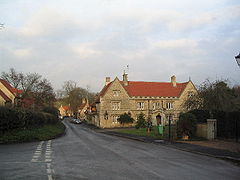
Summary
Irnham is a village and civil parish in South Kesteven, Lincolnshire, England. It is situated approximately 10 miles (16 km) south-east from Grantham. To the north is Ingoldsby and to the south-west, Corby Glen. The village is on a high limestone ridge that forms part of the Kesteven Uplands.
| Irnham | |
|---|---|
 The Griffin Inn, Irnham | |
 Irnham Location within Lincolnshire | |
| Population | 206 |
| OS grid reference | TF024267 |
| • London | 90 mi (140 km) S |
| Civil parish |
|
| District | |
| Shire county | |
| Region | |
| Country | England |
| Sovereign state | United Kingdom |
| Post town | Grantham |
| Postcode district | NG33 |
| Dialling code | 01476 |
| Police | Lincolnshire |
| Fire | Lincolnshire |
| Ambulance | East Midlands |
| UK Parliament | |
The civil parish of Irnham includes the hamlets of Bulby and Hawthorpe. The similar extent ecclesiastical parish is Irnham, part of the Beltisloe rural deanery in the Diocese of Lincoln, and part of a Group which includes Corby Glen and Swayfield, sharing a single priest. The parish church is dedicated to St Andrew.
History edit
Irnham is listed as "Gerneham" in the Domesday Book of 1086. It was probably founded by an Anglo-Saxon thegn named Georna, hence Georna's Ham (or settlement). Scenes of 14th-century life in the village are depicted in the Luttrell Psalter.[1][2]
Irnham Hall edit
Irnham Hall was the ancient seat of the Paynells and from about 1200, the Luttrell family, Lords of Irnham until 1418. The Manor then passed by marriage to the Hilton family and similarly in 1510 to the Thimbleby family, by whom the present Tudor house was built in about 1600.[3] In 1430, Godfrey Hilton, a knight, was residing in "Irenham".[4] Mary Thimelby was born at the hall in about 1618 and became a prioress.[5]
In 1853 William Hervey Woodhouse (d. 1859), who married Sarah Ellen Cole,[6] bought the Hall, which had several further owners until purchased in 1901 by the present owners, the Benton Jones family. A fire in 1887 destroyed much of the interior.[7]
Thimblesby's Almshouses edit
The village almshouses, built in 1712, are still in use.[8]
St Andrew's Church edit
St Andrew's Church is late Norman with Perpendicular additions, and was heavily restored in 1858, and again in 2006. It holds the tomb and Easter Sepulchre of Geoffrey Luttrell, who commissioned the Luttrell Psalter, a celebrated medieval manuscript now in the British Library, in the early 14th century.[9]
Employment edit
The village public house is the Griffin Inn on Bulby Road. Most other employment is in farming.
References edit
- ^ "British Library page about the Psalter".
- ^ Sancha, Sheila (1983). The Luttrell Village: Country Life in the Middle Ages. Ty Crowell. ISBN 978-0-690-04323-5. A children's interpretation[page needed]
- ^ Historic England. "The Hall (348432)". Research records (formerly PastScape). Retrieved 22 August 2009.
- ^ Plea Rolls of the Court of Common Pleas; National Archives; CP 40 / 677; 4th entry from the bottom, where he is being sued for debt by Ralph Barton, a London skinner
- ^ "Thimelby, Mary [name in religion Winefrid] (1618/19–1690), prioress of St Monica's, Louvain, and author". Oxford Dictionary of National Biography (online ed.). Oxford University Press. 2004. doi:10.1093/ref:odnb/105825. ISBN 978-0-19-861412-8. Retrieved 30 January 2021. (Subscription or UK public library membership required.)
- ^ Hatchment hung on tower arch, Irnham church
- ^ Book of British Villages. Drive Publications Ltd. 1980. p. 235.
- ^ Historic England. "Thimblesby's Almshouses (348422)". Research records (formerly PastScape). Retrieved 22 August 2009.
- ^ Historic England. "Church of Saint Andrew (348411)". Research records (formerly PastScape). Retrieved 22 August 2009.
External links edit
- Media related to Irnham at Wikimedia Commons
- Village website
- "Irnham", The villages around Bourne, Lincolnshire, England, Homepages.which.net


